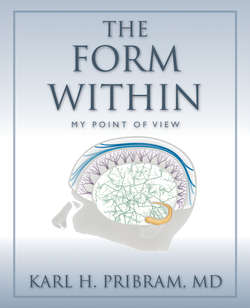Читать книгу The Form Within - Karl H Pribram - Страница 10
На сайте Литреса книга снята с продажи.
The Story
ОглавлениеMost of The Form Within is organized according to topics and issues of general interest as viewed from the vantage of those of us working within the sciences of brain, behavior and mind. However, in the first three chapters, I address issues such as how to proceed in mapping correlations, a topic totally ignored in the current surge in using fMRI to localize the relations between brain and behavior; how I came to use metaphors and models, which is just coming into focus in doing experiments in psychology; and how I came to describe self-organizing processes in the fine-fiber webs and the circuitry of the brain.
The main body of the text begins with the topic of perception. Of special interest is the fact that, contrary to accepted views, the brain does not process two-dimensional visual perceptions; rather, the brain handles many more dimensions of perceptual input. This conclusion is reached because I make a distinction between the functions of the optic array and those of retinal processing. Furthermore, evidence shows that there is as much significant input from the brain cortex to the receptors as there is input from the environment.
In a subsequent chapter, I present evidence to show that the brain’s control of action is by way of “images of achievement,” not just motor programs—and the resultant support of the currently dismissed “motor theory” of language acquisition.
And there is more: The neural processing of pleasure, which accounts for the intertwining of pain- and temperature-transmitting fibers in the spinal cord, is shown to be straightforward; so is the evidence for how brain processes are involved in setting values and making choices, as well as how brain processes compose, through interleaving cognitive with emotional/motivational processes, the formation of attitudes.
Finally, a series of chapters is devoted to new views on encompassing issues such as evolution, memory, consciousness, mind/brain transactions, and the relation between information processing and meaning. These chapters challenge, by presenting alternatives, the prevailing views presented by philosophers of science, especially those concerning the relation between brain and mind. Much of what composes these and other chapters of The Form Within cannot be readily found in other sources.
The first three chapters that follow this preface are organized, somewhat in the order that I utilized them, according to three different types of procedure that I used to study what the brain does and how it does it: 1) Correlations, 2) Metaphors and Models, and 3) The Biological Imperative.
By correlations I mean discoveries of relationships within the same context, the same frame of reference (the same coordinate systems.) We humans, and our brains, are superb at discovering correlations, sometimes even when they are questionable. Such discoveries have abounded during the two past decades, by way of PET and fMRI image processors, techniques that have provided a tremendous surge of activity in our ability to make correlations between our brain, behavioral and mental processes. But correlations do not explain the processes, the causes and effects that result in the correlations.
Metaphors and models, by contrast, are powerful tools that we can use to guide our explorations of process. We can model a brain process that we are exploring by doing research on a device, or with a formulation that serves as a metaphor, and we can then test in actual brain research whether the process that has been modeled actually works. The Form Within uses telephone communications, computer programs, and optical-engineered holographic processes wherever relevant. For the most part our metaphors in the brain/behavior/mind sciences come from engineering and mathematics.
Brain and behavioral research (such as that obtained through correlation and the use of metaphors) often develops questions that lead directly to brain physiological research. My research led to understanding a biological imperative: the self-organizing property of complex processing.
In subsequent chapters of The Form Within—the topic-oriented chapters—I have noted the results of the application of the insights obtained as they become relevant.
